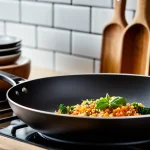How UK Kitchen Design Supports Healthy Living
Discovering how thoughtful spaces encourage wellness
UK kitchen design increasingly focuses on promoting healthy living by combining aesthetics with functionality. A core principle is creating layouts that encourage efficient meal preparation, making home cooking more accessible and enjoyable. This often translates into ergonomic work zones and ample storage that reduce clutter, enabling better focus on nutritious cooking.
Also to read : Discover minimalist magic: transform your uk kitchen design with simplicity
The impact of kitchen design on cooking and eating habits is significant. By integrating features like easy-to-clean surfaces and smart appliances, UK kitchens reduce barriers to preparing balanced meals. Such environments inspire users to choose wholesome options over convenience foods, fostering healthier lifestyles.
Contemporary UK-specific trends emphasize natural lighting, ventilation, and the use of non-toxic materials, contributing directly to kitchen health benefits. These elements improve air quality and minimize exposure to harmful substances, creating a safer, more inviting space for families. Additionally, the rise of open-plan kitchens encourages social interaction during meal prep, reinforcing positive eating habits and overall well-being.
This might interest you : Unlocking minimalist culinary mastery: transforming uk kitchens for simplicity and flavor
In essence, UK kitchen design strategically supports healthy living by addressing physical, environmental, and behavioral factors within the home. This holistic approach underscores the kitchen as a pivotal space for health and happiness.
Ergonomic Kitchen Layouts for Better Health
Enhancing usability and comfort through smart design
An ergonomic kitchen design focuses on creating a space that prioritizes user comfort and efficiency while minimizing physical strain. Among the most favored kitchen layouts in UK homes are the L-shaped and U-shaped designs, which promote smooth workflows and easy access to essential areas. These layouts reduce unnecessary walking and awkward postures, crucial for those spending long hours cooking or with mobility concerns.
Incorporating principles of functionality, these layouts arrange work zones—cooking, cleaning, and preparation—in close proximity, reducing repetitive bending and stretching. For example, positioning the sink near the stove allows for quick transitions between tasks, which helps prevent back and shoulder strain.
Experts emphasize that an ergonomic kitchen layout should consider countertop heights tailored to users’ needs and the strategic placement of appliances. This approach leverages natural body movements, improving efficiency and minimizing fatigue. Adopting these thoughtful arrangements can transform a kitchen from a chore-heavy space into one that actively supports better health and well-being during daily use.
Choosing Natural and Sustainable Materials
Find harmony between style and eco-conscious living
Opting for natural materials is a cornerstone of sustainable kitchen design. These substances not only reduce environmental impact but also contribute to a healthier home atmosphere by limiting exposure to harmful chemicals often found in synthetic options. In eco-friendly kitchens, natural elements like wood, stone, and recycled materials offer durability and timeless beauty.
In the UK, wood from responsibly managed forests is a popular choice, appreciated for its warmth and renewability. Stone surfaces, such as granite and marble, provide longevity and a low-maintenance finish while being natural and sustainable. Additionally, recycled materials—for instance, glass or composite countertops—bring innovation to kitchen design by repurposing waste, aligning with zero-waste principles.
Integrating these materials showcases how sustainability and elegance merge seamlessly. Imagine a kitchen with raw oak cabinets paired with polished granite countertops or recycled glass backsplash tiles that reflect light beautifully. Such choices define modern UK kitchens committed to ecological responsibility without compromising on aesthetic appeal.
By prioritising natural materials, sustainable kitchen design nurtures both the environment and well-being, creating spaces that are as healthy as they are stylish.
Smart Storage Solutions Encouraging Healthy Habits
Organizing your kitchen with space-saving kitchen tricks can transform meal prep, encouraging healthier eating. Efficient kitchen storage ideas focus on accessibility and visibility, making fresh produce and wholesome ingredients easy to reach. For example, using clear containers for nuts, grains, and seeds highlights healthy staples, reducing impulse choices.
To encourage healthy habits, store fruits and vegetables in transparent, labeled baskets or bins on countertops or dedicated shelves. This not only showcases their freshness but also serves as a reminder to include them in your daily diet. Incorporate stackable shelves and adjustable racks to maximize limited counter and cupboard space, common in many UK homes.
Clutter-free kitchens reduce stress and promote mindful cooking. Regularly declutter and categorize similar items together. For compact UK kitchens, consider multi-tiered storage racks or pull-out drawers that make use of vertical spaces. These smart organization tips ensure everything you need is within arm’s reach, cutting down prep time and keeping your kitchen inviting.
By adopting these healthy kitchen organization strategies, your kitchen becomes a practical, uplifting space that supports a balanced lifestyle without sacrificing style or efficiency.
Selecting Appliances to Facilitate Nutritious Cooking
Enhancing health through smart kitchen choices
When aiming for healthy cooking, choosing the right kitchen appliances is crucial. Appliances like steamers, air fryers, and multi-cookers are standout options that retain nutrients and reduce the need for excessive oils or fats. These tools simplify preparing meals rich in vitamins, minerals, and natural flavors.
In the UK, a growing trend is visible: consumers increasingly select smart kitchen tech to support their well-being. For example, smart ovens with preset modes for vegetables or grains ensure optimal cooking temperatures, conserving nutrients. Additionally, connected appliances allow users to monitor cooking remotely, helping maintain precise timing crucial for nutrient preservation.
To integrate these tech aids effectively:
- Opt for appliances offering customizable temperature control.
- Choose devices with easy-to-clean, non-toxic surfaces to prevent contamination.
- Use smart kitchen tech that syncs with apps for meal planning and nutritional tracking.
Such technologies not only encourage nutritious cooking but also save time, making healthy habits more sustainable in busy lifestyles. Selecting these kitchen appliances adapts your kitchen into a wellness hub, ensuring every meal supports your nutrition goals.
Inspiring Real-Life Healthy UK Kitchen Transformations
Discovering a kitchen makeover that aligns with health goals starts with seeing how others have transformed their spaces. Across the UK, many homeowners have reimagined their kitchens not only for style but to encourage nutritious cooking habits. These UK kitchen case studies showcase practical design changes that have a tangible impact on daily routines.
One common feature in healthy kitchen inspiration is the installation of ample storage for fresh produce and whole foods, promoting easy access and visibility. Bright lighting and clutter-free countertops motivate cleanliness and food preparation that prioritises wellness. Open shelving often replaces bulky cupboards to display mason jars of grains and legumes, creating a visual nudge towards better eating.
Before-and-after photos highlight how simple adjustments—like switching to sustainable materials, adding herb gardens by windows, or upgrading to energy-efficient appliances—can transform functionality and aesthetics. These examples inspire readers considering their own kitchen updates, showing that it’s possible to merge beauty and health seamlessly.
For those planning a kitchen overhaul, numerous resources offer guidance on layout optimisation, product selection, and colour schemes tailored to boost wellbeing. Embracing these insights makes the prospect of a healthier kitchen both exciting and achievable.


